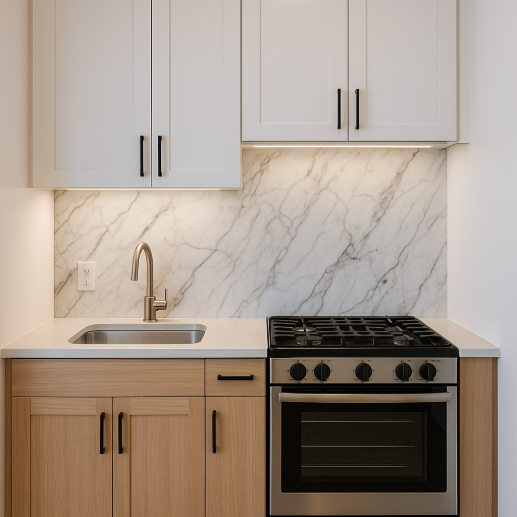Table of Contents
The moment I stepped into my first rental, I knew exactly what I wanted it to feel like: calm, bright, quietly luxurious. The reality was eggshell walls, tile grout that told the story of past tenants a little too well, and a kitchen backsplash that seemed allergic to looking clean. I daydreamed about real marble for about five minutes long enough to Google the price and picture myself negotiating a slab into an elevator before I started looking for a smarter path. That’s when PVC marble sheets wandered into my life. They promised the mood I wanted without the money I didn’t have, they were kinder to landlords than I expected, and they turned out to be the rare upgrade that looks expensive but behaves like it knows you’re renting. If you’re chasing the same luxury look on a reasonable budget, this is the roadmap I wish I’d had from day one.
Why PVC Marble Sheets Make Sense for Renters
Rentals are tricky. You want the place to feel like you, but you also want your deposit back and your weekends free. PVC marble sheets thread that needle better than anything else I’ve tried. They’re large-format panels that look like marble, but they’re lightweight, non-porous, and forgiving. Instead of dozens of grout lines that go dingy overnight, you get a smooth surface that wipes clean with warm water and a mild soap. Instead of a permanent stone install that requires a contractor and permission from the HOA board and their third cousin, you get a smart surface you can mount in renter-friendly ways or, with landlord approval, adhere more permanently while keeping edges crisp and reversible with the right prep.
The other quiet benefit is psychological. The marble look reads elevated even when the rest of the room is doing its best on a budget. A single continuous panel behind a vanity or along a short backsplash can make the whole apartment feel like it leveled up. It’s the classic “one great coat” trick of interiors: give the eye something refined to rest on, and the room relaxes around it.
The Permission Conversation That Actually Works
Before a single panel enters your elevator, have a straightforward conversation with your landlord or building manager. I’ve learned to frame it in three points. First, describe the upgrade as a surface finish, not a renovation. You’re applying panels the way someone would apply wainscoting or beadboard. Second, explain that the panels are non-porous, easy to clean, and designed for wet rooms, which means fewer calls about peeling paint or stained grout. Third, promise reversibility. If you’re using minimal fasteners or adhesive over sound paint, offer to return the wall to a smooth, primed state at move-out. Most landlords aren’t against improvement; they’re against surprises. Clarity wins.
If your building is strict, consider a completely reversible approach for dry zones: mount panels on a thin plywood backer that’s screwed into existing studs using the same locations as your TV mount or shelving. When you leave, you remove the backer, patch a handful of holes, and take your marble wall with you.
Where Panels Make the Biggest Difference in Small Spaces
Small apartments teach you the value of a targeted upgrade. In kitchens, a PVC marble backsplash is a transformation in an afternoon. Run the panel from countertop to the underside of the upper cabinets, and if you can, from corner to corner. The lack of grout lines makes even a compact galley feel intentional. Behind the stove, pair the panel with a slim glass guard if you’re cooking on gas; the combo keeps the marble look while protecting the wall from direct heat and sauce theatrics. If the kitchen ends in a blank side of a cabinet run, wrap that end panel in the same sheet so the whole nook looks custom.
Bathrooms love PVC marble. A single panel behind the vanity reads like a hotel upgrade and protects paint from the daily splash zone. If your landlord allows it, a three-wall shower surround in panels will change your relationship to cleaning forever. If they don’t, you can still add a removable feature behind open shelves or around a mirror to get the mood without touching tile.
Living rooms might be the stealth winner. A TV wall clad floor-to-ceiling in a light, subtle vein instantly elevates the space and softens glare, especially in satin finish. Because the panels are large, the wall reads like stone rather than wallpaper, and the screen feels integrated rather than tacked on. Add a low, warm wood console and the whole vignette looks expensive even if your sofa is still the one you bought on a student budget.
Choosing Size, Thickness, and Finish for Rentals
You don’t need the biggest or heaviest sheet to get the best result, but you should choose with logistics in mind. I measure the wall height, then check my building’s tightest doorway or elevator depth. If a single 4×8 sheet can ride the elevator and cover the height in one run, great. If not, two smaller sheets with a clean seam placed intentionally centered behind a TV, hidden behind a fridge edge, or aligned with a cabinet line will look better than trying to muscle a 10-foot panel up a stairwell that clearly hates you.
For thickness, the sweet spot in rentals is the mid range. It sits straighter on slightly imperfect walls and gives crisp outside corners where you choose to leave an edge exposed, but it’s still light enough to stage on a pair of blankets in your living room. In dry areas, a thinner panel is okay if your wall is flat and you’re fastening to a backer. In busy kitchens and baths, the mid thickness feels and cleans better.
As for finish, satin is your friend. Gloss can be glam, but it gleams like a mirror and tattles on fingerprints and lamp reflections. Satin looks like honed stone calm, elegant, and forgiving. Pattern-wise, think about scale. Big, swoopy veins love big walls. Fine, feathery veining is perfect in galley kitchens, powder rooms, and anywhere close viewing distances might make bold patterns feel busy.
Renter-Friendly Ways to Mount Panels
There are three approaches I’ve used in rentals, each with its own balance of ease, cost, and reversibility. The first is the backer-board method for dry zones. Cut a thin plywood or composite sheet to the exact wall size, mount your PVC marble panels to it, and hang the assembly on a French cleat screwed into studs. The whole feature becomes like a giant piece of art you can remove later with a handful of patched holes.
The second is a light fastener method, where you attach panels directly to the wall with small countersunk screws at edges, then finish with trims that cover the screw heads. This works well in living rooms and bedrooms and is simple to reverse. The third is fully adhered panels with a panel-rated adhesive, best for bathrooms or kitchens where water is a daily guest. If you go this route, do it with the blessing of your landlord and commit to returning the wall to smooth paint at move-out. Adhesives today are strong and clean; demo later will mostly be a patient peel, a skim coat, and a prime.
No matter which path you choose, treat seams with care. A tiny, even bead of color-matched silicone, tooled once and left alone, is the difference between “DIY” and “did you hire a designer?” Corners love a slim L-trim; outside edges near traffic look finished with a square reveal.
Costs That Feel Honest for Renters
Let’s talk numbers the way a lease talks numbers. Materials include the panels, trims, adhesive or fasteners, and a few tools if you don’t already own them. A small kitchen backsplash often takes one 4×8 sheet plus trims and consumables, and the total tends to land in the realm of a weekend splurge that still lets you eat next week. A bathroom vanity wall is similar, especially if you use offcuts wisely. A full shower surround costs more, but it also robs your cleaning caddy of its most exhausting chore. Compared to stone or tile, you save on demolition, labor, and time living in a plastic-draped set. Compared to peel-and-stick film, you get a finish that reads like architecture instead of a sticker.
The hidden budget killer is “just one more” store run. Overbuy by a small margin on adhesive, silicone, and trims. The extra tube and stick will vanish into your next project or a friend’s, and you’ll finish this one with your sanity intact.
Cleaning, Maintenance, and Life Between Work and Dinner
Daily life is where PVC marble sheets shine for renters. You don’t baby them and they still look unbothered. After cooking, splatters wipe away instead of slowly dyeing grout. After a steamy shower, a quick swipe with a microfiber cloth keeps the satin face from hosting water spots. There’s no annual sealing ritual, no “only use this soap” lecture, no fear that a guest will etch your wall by setting down a lemon wedge. In apartments where storage is a premium, not having a shelf of specialty cleaners is its own quiet luxury.
Small Space Tricks that Make It Feel Like the Model Suite
Apartments reward restraint. A single marble-look field behind open shelving turns Ikea wood into “did you get that custom?” A panel behind the bed, the width of your headboard and full height to the ceiling, anchors the room like a built-in headboard wall. In entryways, a wainscot-height run of panels keeps bags and umbrellas from tattooing the paint and makes even the mail drop feel considered. In all these spots, lighting is the secret. A soft wall washer or a pair of dimmable sconces grazing a satin panel adds dimension, hides sins, and makes evenings feel composed.
HOA, Elevators, and the Neighbor Factor
Condos and high-rises add a layer of logistics. Book the elevator during off-peak hours, pad the corners, and measure your panel and the cab before you order so you don’t meet a physics problem in the lobby. Some HOAs want to know about “construction materials” coming through the building. I’ve found that the phrase “pre-finished decorative wall panels, no wet work, no noise beyond daytime hours” calms everyone down. Also, be that neighbor who protects hallway floors and vacuums as you go. It’s amazing how fast a building warms up to your project when the common areas look exactly as they did at 9 a.m.
Move-Out Without Drama
If you mounted on a backer or used light fasteners, unscrewing, patching, and priming is an easy Saturday with a podcast. If you adhered panels, peel carefully with a broad knife, take your time, and plan a skim coat so the wall looks better than it did when you moved in. Keep a small folder of “before” photos and your landlord’s written approval. Deposits go smoother when you treat the close-out like you treated the install: calm, clear, and considerate.
The Emotional ROI No Spreadsheet Captures
There’s a moment after you finish when the apartment feels like it exhaled. Morning light softens across the “stone,” the kitchen looks styled before you’ve rinsed a mug, and your friends do that double-take and ask if you renovated. You didn’t. You edited. You chose one or two surfaces to elevate and let everything else play nicely around them. That’s the heart of getting a luxury look on a renter’s budget. You’re not buying a different life; you’re buying the feeling that the life you already have belongs in a beautiful frame.
A Simple Plan to Start This Weekend
Take honest measurements of the wall you want to change and the narrowest path from the lobby to your unit. Order two samples in the pattern you love one bold, one subtle and tape them up for a day. Choose satin unless you’re craving reflection. Decide your mounting approach based on your lease and your landlord’s goodwill. Gather trims, adhesive or fasteners, painter’s tape, a fine-tooth blade, and a caulk you can control. Dry-fit first, align the veining like a sentence, run continuous adhesive beads if you’re bonding, and tool seams once before you walk away. Let it cure overnight. Then make coffee in a kitchen that feels like it belongs in the nice part of your Pinterest board.
If you want help tailoring the plan to your lease and layout, tell me your wall height, building constraints, whether you need a fully reversible install, and the vein style that makes you smile soft and clouded, or bold and architectural. I’ll sketch a seam plan, suggest trims and a mounting method that protects your deposit, and help you turn a rental into a place that quietly says “home” every time you walk in.



